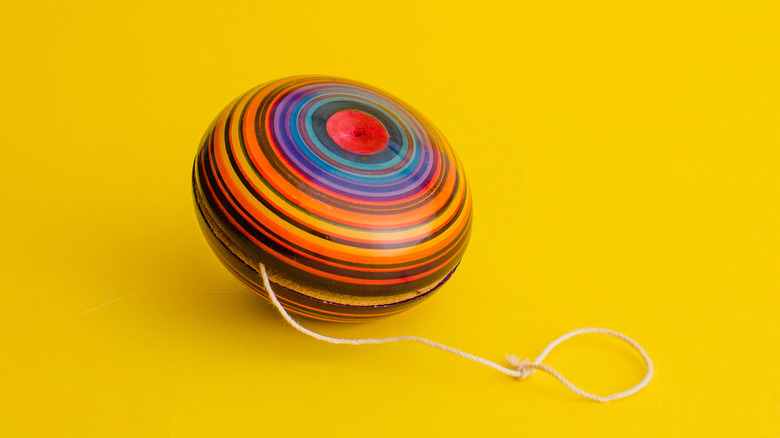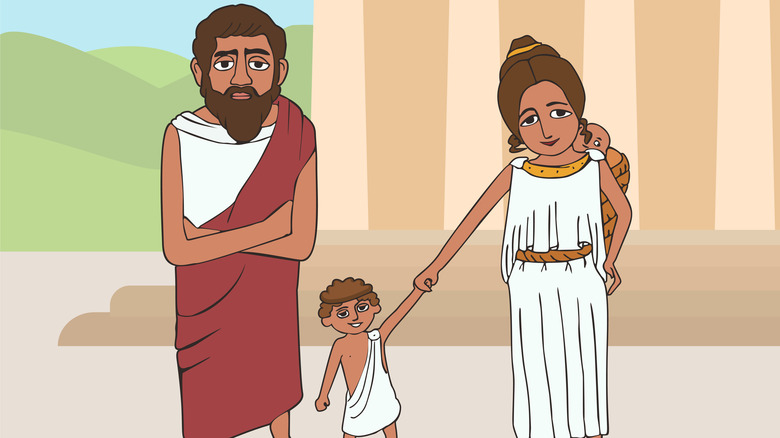Why The Yo-Yo Played An Important Role In Ancient Greek Society
Like hairstyles and living room decor choices, fads in the world of children's toys come and go. Sometimes they come right back again after a decade or two. In other cases, they remain a distant memory, spoken of only by the older generation: dire reminders of the bizarre and terrible choices they made in the past.
Perhaps the very same thing will happen to us one day, with our silly social media challenges and trends. In the meantime, though, let's celebrate one of those toys that has bobbed in and out of relevance for decades. Well, centuries, in this case: the humble yo-yo.
In today's modern era of tablets, smartphones and children's TV, there are still some classic toys that remain firm favorites. Wooden blocks, dollhouses, the dolls themselves, and model cars are staples that millions of children around the world have grown up with. The yo-yo, while it requires a little more dexterity (and therefore age) to competently and safely operate, is also iconic. According to Britannica, the ancient Greeks were the first to make reference to a yo-yo, which they made of materials like wood, circa 500 BCE. The device may reportedly date even further back to ancient China.
Even if the Greeks didn't make the world's first yo-yos, they certainly attributed a lot of societal significance to the device. Here's how the yo-yo may have had a huge impact on ancient Greek childhoods, in more ways than one.
The fascinating history of the yo-yo
The National Yo-Yo Museum shares the story of Pedro Flores, as recounted in "Lucky's Guide to YoYo Collecting." Flores, it seems, started the Yo-Yo Manufacturing Company in Santa Barbara in 1928, making the name for the device 'official' for the first time (it had reportedly been known as a bandalore prior to this). In June of that year, Flores sold his first small batch of yo-yos, made by his very own hands, to children who happened to be in the area. His concept was so successful that, before the year was out, his company had the resources it needed and he was no longer toiling by hand. Before the 1930s arrived, Flores' yo-yo empire was pumping out 300,000 of them every single day.
Around 100 years have passed since Flores' endeavors began, but the yo-yo has just kept coming up again and again (that's what they do, after all). The Strong National Museum of Play, states that the device was gradually refined with additions like ball bearings, to enhance performance. In April 1985, astronauts aboard the Discovery space shuttle played with the first yo-yo in space. Or, rather, conducted serious scientific experiments in space using the device.
For the Ancient Greeks, it seems, the yo-yo was so much more than just a toy. Children are depicted on pottery playing with them, per the outlet, but it seems they may have had a ceremonial purpose in their passing to adulthood too.
Playtime was so much more than that
The National Museum of Athens reports that its collection houses "dozens of objects, rattles, spinning tops, slings, balls, and puppets — physical or in representations — which differ little from modern toys." Among them, according to the Greek Reporter, are examples of ancient Greek yo-yos. This outlet states that yo-yos and other toys may have been offered as a sort of ritual to mark children's symbolic (and literal) progression to adulthood.
The BBC reports that the ancient Greek word for child translates to "someone who plays." Véronique Dasen of the University of Fribourg explained, per the outlet, "there is something special in children, and this special value is revealed by their fondness for play. And adults recognized that." What happened after this precious playtime? An offering may have been made of those childhood toys.
It's vital to note, though, that items from the distant past can easily be misinterpreted. What appeared to have been a yo-yo may instead have been an iynx: a different sort of object of similar design, but which was instead used by adults (as a sort of love charm). Dasen discusses the object in December 2018 study "Histoire et archéologie de la culture ludique dans le monde gréco-romain. Questions méthodologiques" (ResearchGate), via the BBC.
The yo-yo, the iynx, the legend
The concept of offering up toys (and similar ritualistically-important objects that resemble toys, like figurines and models) is not a new one. In the 1994 study "Playing with God: Cultural perceptions of children, play, and miniatures in the Andes" (ResearchGate), from Bill Sillar discusses similar behaviors in this society. "Miniatures in the Andes," Sillar writes, "are also used in curing, burnt offerings (dispachu), attached to saints and placed in nativity scenes ... much of the ritual importance of miniatures actually comes from their association with children and playing."
Perhaps, then, the yo-yo held a similar position in ancient Greek society. Some of the terracotta objects and remnants may indeed have been an iynx, but the ancient Greeks were known to have played with yo-yos. Whether they had this ritual value or not, they were certainly a huge part of children's growth.
In the words of Gentry Stein, world yo-yo champion in August 2014 (via MTV), "Yo-yoing has changed so much from what most people think — like it's some lame children's toy. It's obviously completely different than that. There's a lack of knowledge of what it has become." In terms of its significance, whether ritual or as a competitive sport, it's clear that the yo-yo has always been something very special.



